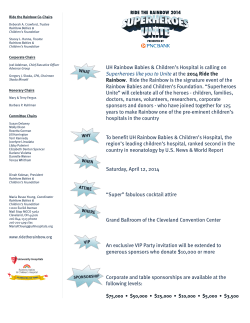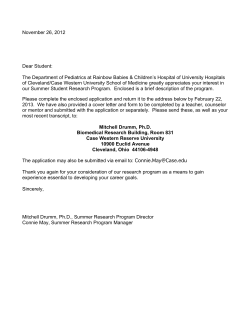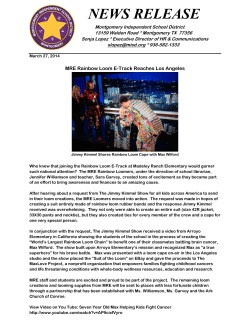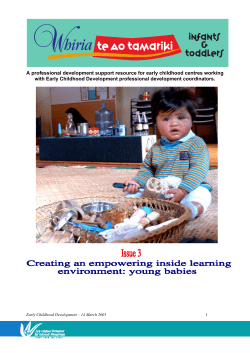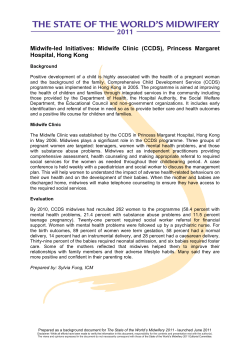
2012 Community Health Needs Assessment
2012 Community Health Needs Assessment University Hospitals’ (UH) long-standing commitment to the community spans more than 145 years. This commitment has grown and evolved through significant thought and care in considering our community’s most pressing health needs. One way we do this is by conducting a periodic comprehensive Community Health Needs Assessment (CHNA) for each UH hospital facility. The most current assessments were completed by an external health care consulting service working with UH and include quantitative and qualitative data that serve to guide both our community benefit and strategic planning. Through our CHNA, UH has identified the greatest health needs among each of our hospital’s communities, enabling UH to ensure our resources are appropriately directed toward outreach, prevention, education and wellness opportunities where the greatest impact can be realized. The following document is a detailed CHNA for University Hospitals Rainbow Babies & Children’s Hospital (UH Rainbow Babies & Children’s Hospital). UH Rainbow Babies & Children’s Hospital is a 244-bed, full-service pediatric hospital and academic medical center that is solely dedicated to the health care needs of children. A trusted leader in children’s health care for more than 125 years, UH Rainbow Babies & Children’s Hospital consistently ranks among the top children’s hospitals in the nation. UH Rainbow Babies & Children’s Hospital offers myriad programs and activities to address the surrounding community health needs. These include child safety programs through the Rainbow Injury Prevention Center and Healthy Kids, Healthy Weight ™, a free child obesity treatment program, as well as leading-edge treatment and research programs in clinical areas such as cystic fibrosis, pediatric sickle cell disease, and neonatology. Additionally, UH has responded to community health needs as part the Vision 2010 strategic plan. This monumental community investment of more than $1 billion over five years reaffirms a strong commitment to the UH community. This plan included building UH Ahuja Medical Center, UH Seidman Cancer Center, several outpatient health centers, expanding the UH Rainbow Babies & Children’s Hospital Neonatal Intensive Care Unit, and renovating and expanding the adult and pediatric Centers for Emergency Medicine at UH Case Medical Center. UH Rainbow Babies & Children’s Hospital strives to meet the health needs of its community. Please read the document’s introduction below to better understand the health needs that have been identified. Table of Contents INTRODUCTION . . . . . . . . . . . . . . . . . . . . . . . . . . . . . . . . . . . . . . . . . . . . . . . . . . . . . . . . . . . . . . . . . . . . . . . . . . 1 EXECUTIVE SUMMARY. . . . . . . . . . . . . . . . . . . . . . . . . . . . . . . . . . . . . . . . . . . . . . . . . . . . . . . . . . . . . . . . . . . . . 2 COMMUNITY-WIDE NEEDS. . . . . . . . . . . . . . . . . . . . . . . . . . . . . . . . . . . . . . . . . . . . . . . . . . . . . . . . . . . . . . . . . . 3 PRIORITY NEEDS IN CUYAHOGA COUNTY . . . . . . . . . . . . . . . . . . . . . . . . . . . . . . . . . . . . . . . . . . . . . . . . . . . . . . 5 PRIORITY NEEDS IN OTHER PRIMARY SERVICE AREA COUNTIES. . . . . . . . . . . . . . . . . . . . . . . . . . . . . . . . . . . . . . 6 APPENDIX . . . . . . . . . . . . . . . . . . . . . . . . . . . . . . . . . . . . . . . . . . . . . . . . . . . . . . . . . . . . . . . . . . . . . . . . . . . . A-1 QUALIFICATIONS OF VERITÉ HEALTHCARE CONSULTING. . . . . . . . . . . . . . . . . . . . . . . . . . . . . . . . . . . . . . . . . . A-2 STUDY METHODS. . . . . . . . . . . . . . . . . . . . . . . . . . . . . . . . . . . . . . . . . . . . . . . . . . . . . . . . . . . . . . . . . . . . . . . A-3 A. ANALYTIC METHODS . . . . . . . . . . . . . . . . . . . . . . . . . . . . . . . . . . . . . . . . . . . . . . . . . . . . . . . . . . . . . . A-3 B. DATA SOURCES . . . . . . . . . . . . . . . . . . . . . . . . . . . . . . . . . . . . . . . . . . . . . . . . . . . . . . . . . . . . . . . . . . A-4 C. INFORMATION GAPS. . . . . . . . . . . . . . . . . . . . . . . . . . . . . . . . . . . . . . . . . . . . . . . . . . . . . . . . . . . . . . . A-5 D. COLLABORATING ORGANIZATIONS. . . . . . . . . . . . . . . . . . . . . . . . . . . . . . . . . . . . . . . . . . . . . . . . . . . . A-5 DEFINITION OF COMMUNITY ASSESSED. . . . . . . . . . . . . . . . . . . . . . . . . . . . . . . . . . . . . . . . . . . . . . . . . . . . . . A-6 SECONDARY DATA ASSESSMENT. . . . . . . . . . . . . . . . . . . . . . . . . . . . . . . . . . . . . . . . . . . . . . . . . . . . . . . . . . A-11 A.DEMOGRAPHICS. . . . . . . . . . . . . . . . . . . . . . . . . . . . . . . . . . . . . . . . . . . . . . . . . . . . . . . . . . . . . . . . . A-11 B. ECONOMIC INDICATORS . . . . . . . . . . . . . . . . . . . . . . . . . . . . . . . . . . . . . . . . . . . . . . . . . . . . . . . . . . A-14 1. People in Poverty. . . . . . . . . . . . . . . . . . . . . . . . . . . . . . . . . . . . . . . . . . . . . . . . . . . . . . . . . . . . . . A-15 2. Unemployment Rates . . . . . . . . . . . . . . . . . . . . . . . . . . . . . . . . . . . . . . . . . . . . . . . . . . . . . . . . . . A-15 3. State Budget Cuts. . . . . . . . . . . . . . . . . . . . . . . . . . . . . . . . . . . . . . . . . . . . . . . . . . . . . . . . . . . . . A-16 4. Household Income . . . . . . . . . . . . . . . . . . . . . . . . . . . . . . . . . . . . . . . . . . . . . . . . . . . . . . . . . . . . A-17 C. AMBULATORY CARE SENSITIVE DISCHARGES. . . . . . . . . . . . . . . . . . . . . . . . . . . . . . . . . . . . . . . . . . . A-26 1. County-Level Analysis. . . . . . . . . . . . . . . . . . . . . . . . . . . . . . . . . . . . . . . . . . . . . . . . . . . . . . . . . . A-27 2.Facility-Level Analysis. . . . . . . . . . . . . . . . . . . . . . . . . . . . . . . . . . . . . . . . . . . . . . . . . . . . . . . . . . . A-28 D. COUNTY AND STATE-LEVEL HEALTH STATUS AND ACCESS INDICATORS. . . . . . . . . . . . . . . . . . . . . . . A-29 E. ZIP CODE AND CENSUS TRACT LEVEL INDICATORS. . . . . . . . . . . . . . . . . . . . . . . . . . . . . . . . . . . . . . . A-42 F. MEDICALLY UNDERSERVED AREAS AND POPULATIONS . . . . . . . . . . . . . . . . . . . . . . . . . . . . . . . . . . . A-45 G. HEALTH PROFESSIONAL SHORTAGE AREAS. . . . . . . . . . . . . . . . . . . . . . . . . . . . . . . . . . . . . . . . . . . . . A-47 H. DESCRIPTION OF OTHER FACILITIES AND RESOURCES WITHIN THE COMMUNITY. . . . . . . . . . . . . . . . A-48 I. REVIEW OF OTHER RECENT COMMUNITY HEALTH NEEDS ASSESSMENTS. . . . . . . . . . . . . . . . . . . . . . A-53 1.Lake County Community Health Assessment. . . . . . . . . . . . . . . . . . . . . . . . . . . . . . . . . . . . . . . . . A-53 2. The Center for Community Solutions. . . . . . . . . . . . . . . . . . . . . . . . . . . . . . . . . . . . . . . . . . . . . . . A-53 3. Child and Family Health Services. . . . . . . . . . . . . . . . . . . . . . . . . . . . . . . . . . . . . . . . . . . . . . . . . . A-54 4. The Center for Health Affairs. . . . . . . . . . . . . . . . . . . . . . . . . . . . . . . . . . . . . . . . . . . . . . . . . . . . . A-55 PRIMARY DATA ASSESSMENT. . . . . . . . . . . . . . . . . . . . . . . . . . . . . . . . . . . . . . . . . . . . . . . . . . . . . . . . . . . . . A-57 A. INTERVIEW FINDINGS . . . . . . . . . . . . . . . . . . . . . . . . . . . . . . . . . . . . . . . . . . . . . . . . . . . . . . . . . . . . . A-57 B. COMMUNITY INPUT. . . . . . . . . . . . . . . . . . . . . . . . . . . . . . . . . . . . . . . . . . . . . . . . . . . . . . . . . . . . . . A-61 1. Identification of Public Health Experts. . . . . . . . . . . . . . . . . . . . . . . . . . . . . . . . . . . . . . . . . . . . . . A-62 2. Identification of Health or Other Departments or Agencies . . . . . . . . . . . . . . . . . . . . . . . . . . . . . . A-65 3. Identification of Community Leaders and Representatives. . . . . . . . . . . . . . . . . . . . . . . . . . . . . . . A-65 4. Identification of Other Persons Representing the Broad Interests of the Community. . . . . . . . . . . . A-67 PRIORITIZATION PROCESS AND CRITERIA . . . . . . . . . . . . . . . . . . . . . . . . . . . . . . . . . . . . . . . . . . . . . . . . . . . . A-68 ASSESSMENT SUMMARY. . . . . . . . . . . . . . . . . . . . . . . . . . . . . . . . . . . . . . . . . . . . . . . . . . . . . . . . . . . . . . . . A-69 INTRODUCTION CHNAs seek to identify priority health status and access issues for particular geographic areas and populations by focusing on the following questions: This report identifies and assesses community health needs in the areas served by UH Rainbow Babies & Children’s Hospital in accordance with regulations promulgated by the Internal Revenue Service pursuant to the Patient Protection and Affordable Care Act, 2010. UH Rainbow Babies & Children’s Hospital recognizes that a community health needs assessment (CHNA) is required to meet current government regulation. This assessment is intended to fulfill this purpose although final guidance has not yet been published and has been provided only on an anticipatory basis. • ho in the community is most vulnerable in terms of W health status or access to care? • hat are the unique health status and/or access needs W for these populations? • Where do these people live in the community? • Why are these problems present? The question of how the organization can best use its limited charitable resources to assist communities in need will be the subject of the hospital’s implementation strategy. Prior to the enactment of the new legislation, UH Rainbow Babies & Children’s Hospital had conducted needs assessments to determine community needs and resources to meet those needs. To answer these questions, this assessment considered multiple data sources, including secondary data (regarding demographics, health status indicators, and measures of health care access), assessments prepared by other organizations in recent years, and primary data derived from interviews with persons who represent the broad interests of the community, including those with expertise in public health. The 2012 CHNA, initiated by UH Rainbow Babies & Children’s Hospital, sets out the needs and does not address whether those needs are currently met by one or more community benefit programs already in existence. Rather, this assessment will serve as a foundation for developing an implementation strategy to address those needs that (a) the hospital determines it is able to meet in whole or in part; (b) are otherwise part of its mission; and (c) are not met (or are not adequately met) by other programs and services in the service area. The following topics and data have been assessed: • Demographics; • E conomic issues, e.g., poverty, unemployment, and state budget changes; The UH Rainbow Babies & Children’s Hospital CHNA is the foundation for an implementation strategy as required by the applicable regulations. UH Rainbow Babies & Children’s Hospital is taking a leadership role as both the CHNA and implementation strategy are not required to be completed until 2013. • ommunity issues, e.g., availability of healthcare C facilities and resources, environmental concerns, and crime; • ealth status indicators, e.g. morbidity rates for H various diseases and conditions, and mortality rates for leading causes of death; To assist with the assessment, UH retained Verité Healthcare Consulting, LLC (Verité). More information on Verité is provided in the Appendix. • ealth access indicators, e.g., uninsured rates, H ambulatory care sensitive (ACS) discharges, and use of emergency departments for non-emergent care; • Health disparities indicators; and • Availability of healthcare facilities and resources. 1 EXECUTIVE SUMMARY UH Rainbow Babies & Children’s Hospital Community By the Numbers • Primary Service Area (PSA) Counties: 8 Ashtabula, Cuyahoga, Geauga, Lake, Lorain, Medina, Portage, Summit • 0% of community discharges were for patients 5 with Medicaid; these patients more prevalent in Ashtabula, Cuyahoga, and Summit counties • Secondary Service Area (SSA) Counties: 7 Ashland, Erie, Huron, Mahoning, Stark, Trumbull, Wayne • 24% of households with incomes < $25,000 • Population by race, 2010-2015: • Population under 18, 2010: 915,427 - African American communities proximate to the hospital • 2% of community population resides in 3 Cuyahoga County - Projected decline in white and African American populations • 1% of inpatient discharges originate from the 9 PSA; 58% from Cuyahoga County - Anticipated increase in other non-white populations • Population change 2010-2015: • -6 % decrease in population under 18, the most rapid decline of any age group 2 T here exists a wide range of health status and access challenges across the community At UH Rainbow Babies & Children’s Hospital, 9 percent of discharges were found to be Ambulatory Care Sensitive (ACS) or potentially preventable if patients are accessing primary care resources at optimal rates; 92 percent are for patients aged 0 to 17. The most common conditions were: pediatric asthma, pediatric urinary tract infection, and pediatric diabetes short-term complications. In the UH Rainbow Babies & Children’s Hospital community, ACS discharges are also prevalent for uninsured patients. While the UH Rainbow Babies & Children’s Hospital community benchmarks favorably on a variety of health indicators compared to national and state averages, this assessment focuses on the priority problems that impact the overall health of the pediatric community. UH Rainbow Babies & Children’s Hospital’s service area extends into eight primary service area (PSA) counties: Ashtabula, Cuyahoga, Geauga, Lake, Lorain, Medina, Portage, and Summit, and seven secondary service area (SSA) counties: Ashland, Erie, Huron, Mahoning, Stark, Trumbull, and Wayne. Key findings from analyses of the PSA counties are as follows. The UH Rainbow Babies & Children’s Hospital PSA has many access issues. Twenty-seven PSA ZIP codes in Cuyahoga, Lorain, Portage, and Summit counties have been designated as Medically Underserved Areas or Medically Underserved Populations. Ashtabula, Cuyahoga, Lorain, Medina, and Summit counties each contain primary medical care, mental health, and/or dental Health Professional Shortage Areas (HPSAs). Fourteen medical-facility HPSAs provide pediatric and/or maternal and infant health services. Poverty and unemployment in the area create barriers to access (to health services, healthy food, and other necessities) and thus contribute to poor health. Racial and ethnic minorities are more likely to lack economic and social resources and be at risk for poor health. These issues are most prominent in Ashtabula, Cuyahoga, and Summit counties: • uyahoga and Ashtabula counties had higher poverty C rates in 2010 than the national and state average; Summit County had a higher poverty rate than the national average. • shtabula County also reported a higher A unemployment rate in August 2011 than national and state averages. • T he greatest proportions of lower-income households in 2010 were located in Ashtabula, Cuyahoga, and Summit counties. Community-Wide Needs Poor health status results if a complex interaction of challenging social, economic, environmental, and behavioral factors combined with a lack of access to care is present. Addressing these “root” causes is an important way to improve a community’s quality of life and to reduce mortality and morbidity. The table that follows describes the health issues identified through the assessment as priorities across the entire community served by the hospital. These problems affect at least four of the eight PSA counties. Health issues are listed in alphabetical order. A comparatively large portion of uninsured discharges was found in Geauga County due to a large uninsured Amish population. Like many states, Ohio has been enacting budget cuts that are affecting health and human services providers. These changes include reductions in Medicaid rates, decreases in general revenue fund appropriations to community based organizations, and others. Documentation of the findings presented in this summary is provided in the Appendix. 3 Access to Care Health Conditions • Lack of Affordable and Accessible Care Community residents identified a growing lack of insurance coverage, a lack of physicians and specialists, a lack of preventive care, and a lack of outpatient services as key access problems. • Prevalent Diet and Exercise - Related Conditions High rates of obesity, childhood obesity, diabetes, diabetes mortality, and a lack of diet and exercise are present in much of the community. Infant and Maternal Care • Lack of Affordable and Accessible Dental Care Community residents frequently mentioned difficulty accessing affordable dental care due to a growing lack of dental insurance coverage, high insurance co-pays and deductibles, and general financial hardship. • High Rates of Black Non-Hispanic Infant Mortality Mental and Behavioral Health • Poor Mental and Behavioral Health Status and Lack of Services The community lacks mental and behavioral health services. The community also suffers from high rates of suicide and poor mental and behavioral health status. • Lack of Affordable and Accessible Prescription Medications Community residents frequently mentioned difficulty accessing affordable prescription medications due to growing uninsurance, high insurance co-pays and deductibles, and general financial hardship. Community Outreach • Lack of Health Education Many community residents lack basic health literacy and healthy lifestyle knowledge. Residents often do not know where to seek care for non-emergent issues and how to access services available in the community. •D eclines in Governmental and Philanthropic Funding Sources Safety net providers describe themselves as operating “at capacity” and are increasingly stretched due to higher demand and declines in governmental and philanthropic funding. Social and Economic Factors • Lack of Transportation to Health Services Community residents, particularly low-income and rural populations, report difficulty finding transportation to health services and facilities. • High Rates of Unemployment and Financial Hardship Due to the recent downturn in the economy and in employment, many households are struggling financially. This has led to food and housing insecurity, delays in obtaining any health care, and noncompliance with drug regimens. Health Behaviors* • Poor Dietary Behaviors A high percentage of young males reported taking diet pills, powders, or liquids to lose weight. *Due to a lack of county-level pediatric data, the above youth behavioral issues are based on state-level data collected by the CDC’s YRBSS survey. The behavioral indicators included were greater than 50 percent worse than the national average. • High Rates of Sexual Violence A high percentage of males reported ever being physically forced to have sexual intercourse. • Prevalent Alcohol and Drug Use A higher percentage of young males reported ever using methamphetamines, steroid pills, or shots. Higher percentages of both males and females reported ever using heroin and using a needle to inject any illegal drug. 4 PRIORITY Needs in Cuyahoga County Cuyahoga County is the largest and most urban county in the UH Rainbow Babies & Children’s Hospital community. It accounts for 44 percent of the total PSA population and 32 percent of the 15-county population. It also accounts for 58 percent of the hospital’s discharges. Compared to the other PSA counties, Cuyahoga County has the highest rate of poverty and a comparatively high proportion of residents who are Medicaid recipients. These factors contribute to unique access challenges in the area. Other characteristics of Cuyahoga County are as follows: • Between 2010 and 2015, the pediatric population Health Behaviors in Cuyahoga County is expecting a 9% decrease in population. • High Rates of Unsafe Sex • At 27% in 2009, Cuyahoga County had a higher Infant and Maternal Care percentage of persons under age 18 living in poverty than the state or nation. • High Rates of Black Perinatal Mortality • High Rates of Hispanic Infant Mortality • 4% of Cuyahoga County pediatric discharges were • High Rates of Infant Mortality ACS in 2010, the highest of the PSA counties. The county had a comparatively large percentage of ACS discharges for Medicaid recipients. • High Rates of Neonatal Infant Mortality • High Rates of Post-Neonatal Infant Mortality • Cuyahoga County has the greatest concentration of • High Rates of Single Mothers ZIP codes with “mid to high” and “high” needs in regards to access to healthcare. • High Rates of Teen Pregnancy • High Rates of Very Low Birth Weight Infants • The county contains mental health, dental, and Physical Environment primary medical care HPSA areas and populations. • Poor Air Quality The county ranked unfavorably on a variety of health status and access indicators. The table to the right lists priority health issues specific to the pediatric population in Cuyahoga County. • Poor Community Safety Poor community safety and high homicide rates were reported in the county. Social and Economic Factors When assessing these issues, it is important to note the probable connections between behavioral, social, economic, and environmental factors and health status. For example, high rates of unsafe sex may be correlated with high rates of infant mortality and infant health risk factors. • Low Educational Achievement • High Rates of Emergency Room Use • Lack of Family and Social Support Resources are needed for those who lack family and social support. 5 Priority Needs in Other PSA Counties There are both similar and unique community health needs in the other seven PSA counties: • In 2010, 40% of the UH Rainbow Babies & Children’s Hospital community population lived in these seven counties. • 32% of UH Rainbow Babies & Children’s Hospital’s inpatient discharges originated from these seven counties. • 6% of UH Rainbow Babies & Children’s Hospital’s emergency department visits originated from these seven counties. • Ashtabula, Geauga, Lake, Lorain, Portage, and Summit counties are expecting declines in the pediatric population between 2010-2015. Medina County is expecting growth. • High Rates of Hispanic Infant Mortality (Lorain) • In 2009, Ashtabula and Lorain counties had a higher • High Rates of Infant Mortality (Ashtabula, Summit) percentage of persons under age 18 living in poverty than the state or nation; Summit County had a higher poverty rate than the national average. • High Rates of Low and Very Low Birth Weight Infants (Summit) • High Rates of Neonatal Infant Mortality (Lorain, Summit) • In 2010, the percent of people who are low-income residents was highest in Ashtabula and Summit counties. • High Rates of Post-Neonatal Infant Mortality (Ashtabula) • Ashtabula County had a large concentration of ZIP • High Rates of Premature Births (Summit) codes with “mid to high” or “high” need in regards to access to healthcare. Geauga county ZIP codes had the lowest need. • High Rates of Single Mothers (Lorain) • High Rates of White Non-Hispanic Infant Mortality (Ashtabula, Lorain, Summit) • HPSA areas and populations are located in Ashtabula, Lorain, Medina, and Summit counties. • Lack of Prenatal Care in the First Trimester (Geauga) The other PSA counties ranked poorly on various health status and access indicators. The table to the right lists priority health issues specific to the pediatric population in these counties. Mortality • High Rates of Child Motor Vehicle Death (1-14) (Ashtabula, Geauga, Portage) As in Cuyahoga County, there are probable connections between identified behavioral, social, economic, and environmental factors and health status. For example, poverty and being uninsured likely contribute to high rates of emergency room use in Ashtabula County. Physical Environment • Poor Air Quality (Lake, Summit) • Poor Community Safety (Ashtabula, Summit) Social and Economic Factors • Low Educational Achievement (Ashtabula) Health Behaviors • High Rates of Emergency Room Use (Ashtabula) • High Rates of Smoking (Ashtabula, Geauga, Lake) Data show high rates of smoking and teen tobacco use. • Lack of Family and Social Support (Lorain) Infant and Maternal Care • High Rates of Births to Women Age 40-54 (Geauga, Lake, Medina) • High Rates of Black Perinatal Mortality (Lorain, Summit) 6
© Copyright 2025
